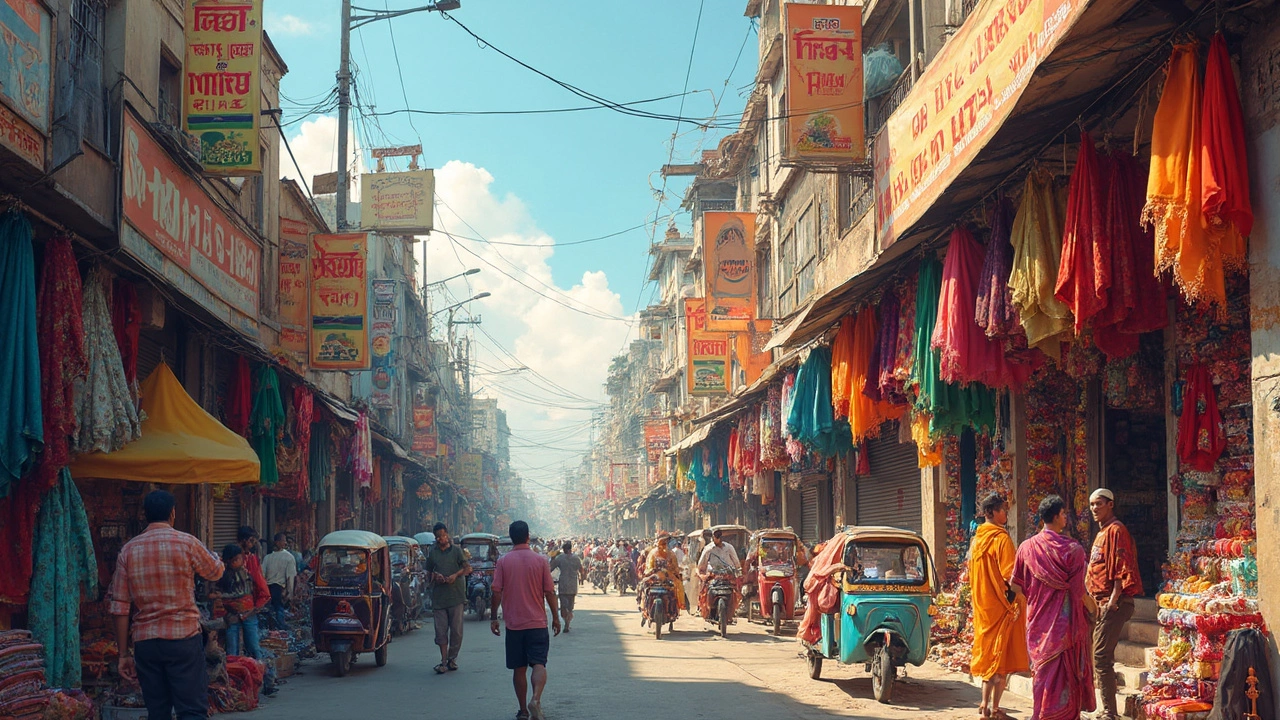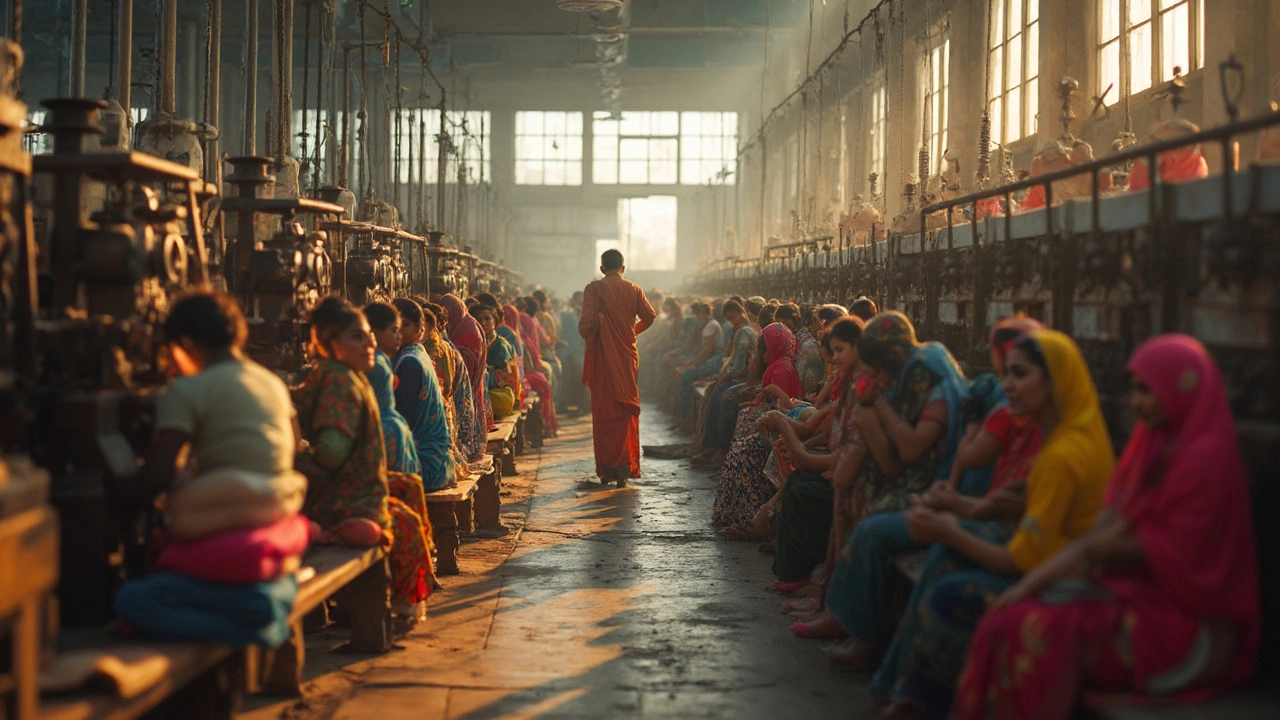Surat isn't just another city on the map—it's the backbone of India's textile industry. If you wear a synthetic saree or spot a shiny dress fabric in a busy mall, chances are it started life in Surat. The city pumps out about 90% of the country’s polyester fabric. That’s billions of meters every single year, fueling small boutiques and big clothing brands alike.
So, what’s the secret sauce? It’s a mix of busy textile markets, high-tech weaving setups, and a workforce that’s practically born to do this work. Textile manufacturers here don't just follow trends—they set them. Whether you’re hunting for the latest sari designs or want to understand why most textile trade shows crowd around Surat-based names, this city never disappoints. If you’re thinking business or just curious about where half your closet comes from, Surat’s textile story gives you both the numbers and the drama.
- Why Surat Dominates the Textile Scene
- Inside Surat’s Massive Textile Markets
- Key Players and Manufacturers
- What Drives Surat’s Growth
- Tips for Doing Business in Surat
Why Surat Dominates the Textile Scene
Surat’s grip on India’s textile industry is no accident. The city sits in Gujarat, right near the Tapi River, which helps with both water and transport. But it’s not just about location—Surat has built a crazy-strong system over time.
Start with the numbers. Surat produces a whopping 40 million meters of fabric per day. That’s enough to wrap halfway around the planet every week if you stacked it end to end. No wonder it’s called the textile manufacturers India king. Over 700,000 people have jobs in the local industry here, from weaving and dyeing to handling giant powerlooms. Many workers come from families who’ve been in textiles for generations, so their skills run deep.
Here’s what gives Surat the edge:
- Tech-obsessed mills: Surat’s factories invest a lot in modern machines. That means more speed, less waste, and fresh designs dropping all the time.
- Sheer scale: The city boasts around 650,000 powerlooms and over 100 textile markets. You name a fabric—Surat’s probably making it right now.
- Central trading hubs: Huge cloth markets like Ring Road and Millennium Market link Surat directly to sellers and buyers across India and even overseas.
Here’s a snapshot of Surat’s textile numbers:
| Fact | Surat |
|---|---|
| Daily Polyester Fabric Output | ~40 million meters |
| Powerlooms in Operation | 650,000+ |
| Employees (direct & indirect) | 700,000+ |
| Share of India’s Synthetic Fabric | Over 90% |
If you’re wondering why labels across India say “Made in Surat,” now you know. Its powerlooms never really stop—it’s like the city never sleeps. The local government has also stepped in to support manufacturers with cash incentives and simplified permissions, which adds fuel to all this growth.
Inside Surat’s Massive Textile Markets
Walk into Surat’s textile zone and you’ll feel the buzz right away. The markets here aren’t just big—they’re sprawling, crammed with fabrics of every color and texture. Everything happens in these tight-packed buildings: weaving, dyeing, printing, trading, and shipping. If you’re looking for action, this is where deals worth crores happen by the hour.
The top spot is the Ring Road area, which is honestly more like a never-ending marketplace than a regular street. You’ll find huge markets like:
- Surat Textile Market (STM) – One of the oldest and most recognized textile trading hubs, packed with rows of shops selling all kinds of fabric, especially synthetic and fancy dress materials.
- Millenium Market, J.J.A.C. Market, Radha Krishna Textile Market – Known for their wholesale deals and direct links to manufacturers. Perfect for retailers wanting to buy in bulk.
- New Bombay Market – Specialized for sarees and dress materials, it attracts buyers from all over India and even outside the country.
Many markets in Surat run practically 24/7 since traders from cities like Kolkata, Mumbai, and Chennai come in to strike early-morning deals. Agents, brokers, and suppliers keep the wheels turning—most of them with contacts built over generations.
Check out this data for a sense of scale:
| Market Name | Specialty | Estimated Shops |
|---|---|---|
| Surat Textile Market | Mixed fabrics, synthetic | 350+ |
| Millenium Market | Polyester, fancy fabrics | 250+ |
| New Bombay Market | Sarees, dress materials | 300+ |
Here’s what really sets Surat apart from other cities as textile manufacturers India: speed and scale. Want to order a new design in the morning? Merchants will promise delivery within days. Many units keep stocks ready for shipping, and the city’s connected railways and airports mean fabrics can reach anywhere, fast.
Want to explore or buy? Bring your GST details if you’re a business. Most serious sellers only work with registered retailers or wholesalers. And don’t be surprised if you see buyers negotiating with several shop owners before settling on a deal—it’s just how business rolls here.

Key Players and Manufacturers
Surat’s textile streets buzz with more than 60,000 textile manufacturers and traders—this isn’t small-time stuff. If you ask anyone in the industry where to look for reliable deals, most will point you straight to Surat. A few names truly anchor the ecosystem here, showing up everywhere from trade fairs to the labels inside your everyday clothes.
Textile manufacturers India know there’s no match for the scale Surat brings. Leading the pack is Vardhman Textiles, a company known for its giant production capacity and focus on quality. Garden Silk Mills is another big fish, famous for churning out polyester fabrics and yarns that end up in exports worldwide. Laxmipati Sarees is a more familiar name if you’re into ethnic wear – their art silk sarees have a footprint all over India and even overseas.
The city’s industry runs on more than brand names. Power loom owners, dyeing and printing firms, and a sea of knitting units create thousands of unique textiles you won’t find anywhere else. The Surat Textile Market, RKTM, and Bombay Market are more like sprawling cities than regular markets, handling buyers from every corner of the country.
Let’s get specific with some numbers and facts:
| Company | Specialty | Daily Output |
|---|---|---|
| Vardhman Textiles | Yarns, Fabrics | 1.2 Million meters |
| Garden Silk Mills | Polyester, Art Silk | 500,000 meters |
| Laxmipati Sarees | Sarees | 100,000 sarees |
| Fairdeal Filaments | Textured Yarn | 450,000 kg |
Want to connect with the right manufacturer in Surat? Here’s what pros suggest:
- Always check production capacity and export experience; busy firms handle overseas orders better.
- Visit Surat Textile Market in person if possible. You get rates straight from the source and see the real quality.
- Shortlist producers who can deliver consistent volume—it saves future headaches for growing brands.
- Most firms digitally sample their latest fabrics online, so checking WhatsApp groups and B2B sites is smart for first-timers.
Surat’s success in textiles isn’t just about knowing how to weave, print, and dye. It’s about how fast the city’s manufacturers adapt, innovate, and get new designs into shops before anyone else does. That’s what keeps Surat far ahead in the textile marathon.
What Drives Surat’s Growth
Surat didn’t just end up as the country’s fabric powerhouse by luck—it’s built on a foundation of smart choices and real advantages. First up, let’s talk location. Surat sits right on key trade routes, and it’s close to a major port in Gujarat. This means finished fabric rolls, dyed yarn, and ready-made garments can be shipped quickly both across India and to countries like Bangladesh, Nepal, and even the Middle East.
The city’s relentless focus on new technology gives it a massive edge. Walk into any factory here and you’ll spot automated weaving machines, digital printing setups, and laser cutting gear. These aren’t just cool to look at—they speed up production and cut down on waste, which is exactly what textile manufacturers India need to stay ahead of global competition.
But it’s not all machines. The human side matters just as much. Surat draws in skilled workers from places like UP, Bihar, and even Rajasthan. You’ll find experienced weavers and designers who know how to churn out thousands of patterns that hit the spot for trends at home and abroad. Local training centers make sure there’s always a steady stream of fresh talent coming in, so no one’s left scrambling for workers.
Let’s not ignore the raw numbers. Surat pumps out nearly 40 million meters of fabric each day. Almost 60% of India’s man-made fiber output comes straight from this city, and industry folks estimate that 70% of all synthetic sarees sold nationwide are Surat products. No other city even comes close to these stats.
Government support seals the deal. The Gujarat state government has launched textile policies, set up dedicated textile parks, and keeps electricity and water rates competitive. Basically, they're making sure Surat stays the top pick for anyone who wants to invest, manufacture, or trade in textiles.
- Strategic location with port access
- Adoption of cutting-edge machinery
- Constant inflow of skilled labor
- Huge daily production capacity
- Strong government backing
Put it all together and it’s clear why Surat stands tall as the textile manufacturers India capital. If you’re working in this industry or planning to, Surat’s growth playbook is a masterclass in how to win big.

Tips for Doing Business in Surat
If you’re eyeing Surat as a place to work with textile manufacturers, a few real-world tips will save you time, money, and headaches. Surat’s textile scene isn’t just huge—it runs on personal connections, quick deals, and knowing the local way things are done. It’s not the kind of place where you land a big order just by sending an email.
Let’s break down some must-knows:
- Textile manufacturers India tend to work fast—really fast. Be ready for short lead times and to make quick decisions. If you drag your feet, someone else might grab the deal.
- Most wholesale deals happen at the buzzing Surat Textile Market and Sahara Darwaja. If you want to compare prices or check quality firsthand, schedule a visit. Walking these markets gives you a real idea of what’s selling and what’s trending.
- Payment terms are usually strict. Most sellers want 100% advance or at least a good chunk upfront when you’re new. Build trust slowly, and terms get a little more flexible.
- Hindi and Gujarati go a long way—English works for big exporters, but the bulk of daily negotiations still happen in the local languages. Even picking up a few phrases can help you out.
- If you plan to set up production, remember that Surat runs mostly on powerlooms for synthetics, while cotton work stays in other regions like Tiruppur. Talk directly to mill owners rather than just relying on middlemen to get better pricing and clarity.
- Visiting during the biggest textile fairs (like the Surat International Textile Expo, usually every January) puts you right in front of top suppliers. It’s where deals get made on the spot.
Bottom line: do your homework, go in person if you can, and don’t be afraid to negotiate. Surat’s market runs on energy, trust, and getting things done quickly—so show you mean business and the city will deliver.
